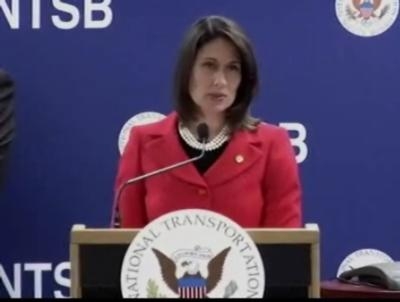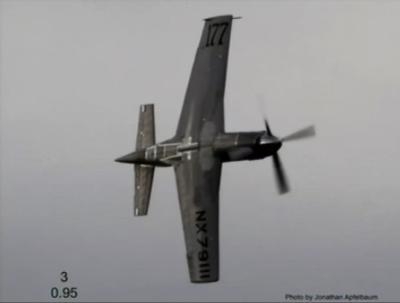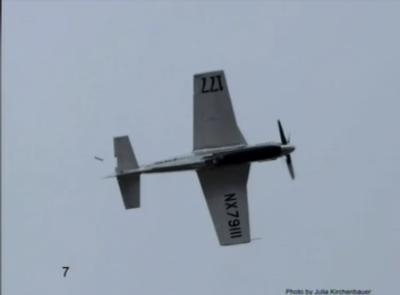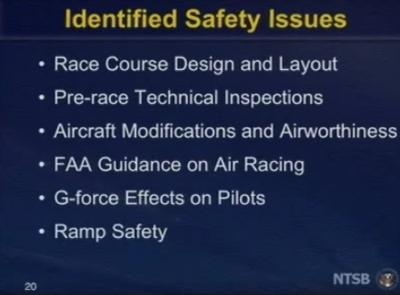Tue, Apr 10, 2012
Holds News Conference In Reno To Announce Suggested Changes
NTSB Chair Deborah A.P. Hersman held a news conference in Reno Tuesday to announce recommended changes in how air races are conducted in an effort to improve safety. "We are not here to put a stop to air racing," Hersman said. "We are here to make it safer."

During the news conference, Hersman showed a series of photographs that documented the accident. At one point prior to the separation of the trim tab, the tailwheel is shown extending, which Hersman attributed to the G-forces being experienced by the airplane. "This pilot in this airplane had never flown this fast on this course," Hersman said. She said that pilot Jimmy Leeward experienced acceleration beyond the nine Gs that could be recorded by the accelerometer in just one second.
While the investigation is ongoing, Chairman Hersman provided a detailed interim update that showed that the accident sequence initiated with an upset that preceded the separation of the left elevator trim tab by approximately 6 seconds.
One key safety area highlighted during the investigation is the extensive modifications made to airplanes that race in the unlimited class and the lack of documentation and inspection associated with those modifications. On the Galloping Ghost, modifications included reducing the wing span from about 37 feet to about 29 feet, and significant changes to the flight controls – all designed to increase speed and enhance racing performance.
The official recommendations made by the NTSB to the National Air Racing Group Unlimited Division include:
- Require aircraft owners in the unlimited class to provide an engineering evaluation that includes flight demonstrations and analysis within the anticipated flight envelope for aircraft with any major modification, such as to the structure or flight controls.
- Develop a system that tracks any discrepancies noted during prerace technical inspections and verifies that they have been resolved.
- Provide high g training to pilots, including techniques to mitigate the potential effects of high g exposure, as part of preparations before the Reno National Championship Air Races (NCAR) and during daily briefs at the NCAR.
- Evaluate the feasibility of requiring pilots to wear g suits when racing at the Reno National Championship Air Races; if the evaluation determines it is feasible, implement a requirement.
The recommendations made for the Reno Air Racing Association include:
- Require aircraft owners, as a condition of eligibility to participate in the Reno National Championship Air Races, to provide an engineering evaluation that includes flight demonstrations and analysis within the anticipated flight envelope for aircraft with any major modification, such as to the structure or flight controls.
- Evaluate the design of the unlimited class course and safety areas to minimize maneuvering near and potential conflicts with spectators; if warranted by the results of the evaluation, implement changes to the race course.
- Take the following actions to raise the level of safety for spectators and personnel near the race course: (1) relocate the fuel truck away from the ramp area and (2) in front of any area where spectators are present, install barriers more substantial than those currently in place.
- Provide high g training to pilots, including techniques to mitigate the potential effects of high g exposure, as part of preparations before the Reno National Championship Air Races (NCAR) and during daily briefs at the NCAR.
- Evaluate the feasibility of requiring pilots to wear g suits when racing at the Reno National Championship Air Races; if the evaluation determines it is feasible, implement a requirement.
Hersman also noted that the board determined that there were inconsistencies in the documents defining the race course at Reno, and that the tools for evaluating event organizer's adherence to air event requirements should contain accurate and consistent information to support a thorough review of a race course and the effort to provide maximum safety for spectators and racers.
To address that issue, the board recommended that the FAA revise its Flight Standards Information Management System section "Waivers: Aviation Events" to correct inaccurate and incomplete information and reconcile all differences and inconsistencies between the documents.



More News
Aero Linx: Florida Antique Biplane Association "Biplanes.....outrageous fun since 1903." That quote really defines what the Florida Antique Biplane Association (FABA) is all about.>[...]
Beyond Visual Line Of Sight (BVLOS) The operation of a UAS beyond the visual capability of the flight crew members (i.e., remote pilot in command [RPIC], the person manipulating th>[...]
Also: ForeFlight Upgrades, Cicare USA, Vittorazi Engines, EarthX We have a number of late-breaking news highlights from the 2024 Innovation Preview... which was PACKED with real ne>[...]
“For Montaer Aircraft it is a very prudent move to incorporate such reliable institution as Ocala Aviation, with the background of decades in training experience and aviation>[...]
Maximum Authorized Altitude A published altitude representing the maximum usable altitude or flight level for an airspace structure or route segment. It is the highest altitude on >[...]
 ANN's Daily Aero-Linx (04.13.24)
ANN's Daily Aero-Linx (04.13.24) ANN's Daily Aero-Term (04.13.24): Beyond Visual Line Of Sight (BVLOS)
ANN's Daily Aero-Term (04.13.24): Beyond Visual Line Of Sight (BVLOS) Airborne 04.09.24: SnF24!, Piper-DeltaHawk!, Fisher Update, Junkers
Airborne 04.09.24: SnF24!, Piper-DeltaHawk!, Fisher Update, Junkers Aero-News: Quote of the Day (04.14.24)
Aero-News: Quote of the Day (04.14.24) ANN's Daily Aero-Term (04.14.24): Maximum Authorized Altitude
ANN's Daily Aero-Term (04.14.24): Maximum Authorized Altitude






